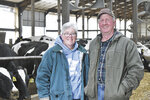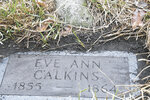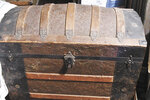



BLUE EARTH, Minn. — Pioneering travels and tragedy cloak four 161-year-old trunks resting from their adventures in the attic of the Calkin family.
Bob and Lori Calkins own a sesquicentennial dairy farm near Blue Earth. Their 300 acres encompass the family’s original homestead claim from 1864.
“It’s a cool thing to know that four, five generations of my ancestors have been here on this farm and started it,” Bob said.
Today, the Calkin family’s dairy farm has its building site a little way from the original home’s foundations, which are still in the woods.
The Calkins milk their cows in a double-8 herringbone parlor they built in 2006.
“(Dairy farming is) a good fit with our farm,” Bob said. “We don’t have a tremendous amount of acres here, and we’re able to utilize some manure and be efficient with the cropping.”
Bob and Lori are assisted by eight full- and part-time employees.
Cows are housed in a freestall barn built in 1999. Calves are housed in hutches inside a hoop barn during the winter and outside during the summer. Lori feeds the calves and likes the hoop house for the winter.
“I don’t have to be in the ice and the rain,” Lori said.
Bob and Lori moved to Bob’s family’s farm in 1988 after Lori finished her education at Iowa State University to become a veterinarian.
The Calkins took over the farm in 1993 and purchased it in 1997.
“I like farm life,” Lori said. “I like the independence; I don’t like the price. But, you have to take the good with the bad.”
When the Calkins moved back in the late ’80s, the farm was milking about 40 cows.
“We just gradually expanded from within, besides a few registered cows we bought,” Bob said. “I had a champagne taste on a beer budget.”
Today, they milk 240 cows. But their story begins in 1863, when Bob’s great-great-grandfather, David, and his wife, Mary, headed west. According to “Martin County, Minnesota History,” they traveled with four young children in an oxen-drawn, covered wagon. Accompanying them were two cows, two heifers, two calves and four trunks.
According to “Martin County’s Heritage,” the Calkins’ ancestors crossed the mighty Mississippi via ferry because there was no bridge. They arrived on the prairies of Minnesota in November 1863 and chose a plot of wooded land on the east side of Lake Burnt Out.
Over the winter, their 9-year-old daughter, Eve Ann, died. According to “Martin County’s Heritage,” she succumbed to diphtheria, which was epidemic at the time. It said she was the first recorded death in the township and that she was buried on the highest point of the farm. Bob said that her burial spot was her favorite vantage point to look over the lake.
Her grave was marked simply with a large stone, the tip of which is visible today. Bob’s parents placed a flat engraved stone marker for her so her burial place would not be forgotten.
Bob’s great-grandfather, Amos, was a child when the family moved to Minnesota. The book tells the story of when a nearby settler decided to move to Sioux Falls, South Dakota. He had Amos help him herd his cattle for the 125-mile journey. It was fall, and when they arrived in South Dakota, 13-year-old Amos was sent back by himself on a poor-quality pony.
Amos made the journey across a prairie with no roads and few settlers. Most of the nights were spent camping on the prairie, fearing wolves and Native Americans. It said Amos thought he was not going to live through it.
The Calkins family has stories of Native Americans camping at their farmstead and other experiences. Care was taken to not disrupt the equilibrium.
Bob and Lori’s home was built in 1918 by Bob’s grandfather, John Calkins. Theirs was the first rural home in Martin County to have electricity, according to “Martin County, Minnesota History.”
John was innovative. According to “Martin County, Minnesota History,” John was born in 1887 and graduated from the University of Minnesota in 1908. He purchased half of the Calkin’s farm from his father, Amos. On it, he created a “model farm,” with the building site in the middle of his land equidistant from his fields.
The Calkins have meticulous records and drawings done by John. They range from hand-drawn maps of their land’s tile ditches from 1908, including elevation, a crop rotation plan for the years 1914-19 and manure charts for the same years.
The lake on the farm, which was quite shallow, was part of a chain of disintegrating lakes in the area. According to “Martin County, Minnesota History,” from 1904-12, Amos was part of a project to help drain the lakes, adding approximately 50 acres to the farm.
In 1946, the Calkins family was an early adopter of artificial insemination. According to a journal article by W. Ombelet and J. Van Robays, the first A.I. cooperative in the U.S. was started by a dairy farmer named E.J. Perry from New Jersey in 1938.
Today, after more than 160 years as a dairy farm, Bob said he does not know what the future will be.
“It’d be really cool to see somebody here using the parlor and the barn,” Bob said. “Frankly, it’s pretty hard to encourage children to do it, just because of what we’ve gone through over the years. ... I’m not saying we regret it.”
Comments
No comments on this item Please log in to comment by clicking here